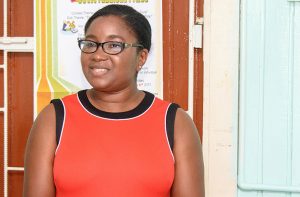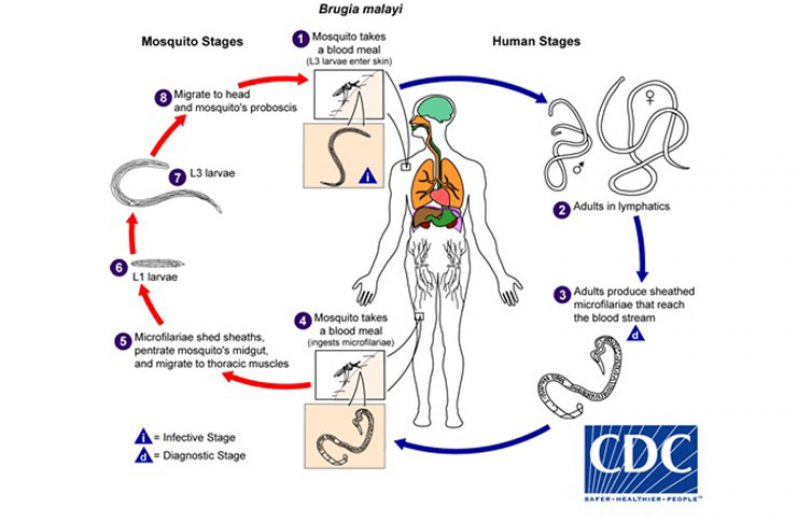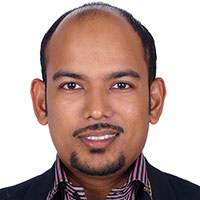— all are urged to participate in the national campaign to eliminate the disease
LYMPHATIC FILARIASIS has been around in Guyana for decades and the stigma attached to it seems very slow in going away, even as Guyana moves to eliminate the disease from within her borders.
Lymphatic filariasis is also known as elephantiasis and is commonly called “Big Foot” in Guyana.
According to the World Health Organisation (WHO), while the infection may be acquired during childhood, its visible manifestations may occur later in life, causing temporary or permanent disability.
It is caused by three species of thread-like nematode worms, known as filariae – Wuchereria bancrofti, Brugia malayi and Brugia timori.

The WHO explains that the worms, both male and female, together form “nests” in the human lymphatic system, the network of nodes and vessels that maintain the delicate fluid balance between blood and body tissues.
The lymphatic system is an essential component of the body’s immune system.
Filarial infection can cause a variety of clinical manifestations. Among them, the WHO noted, are lymphoedema of the limbs, genital disease (hydrocele, chylocele, and swelling of the scrotum and penis) and recurrent acute attacks, which are extremely painful and are accompanied by fever.
While the vast majority of infected people show no symptoms, almost all of them have subclinical lymphatic damage. As many as 40 per cent have kidney damage, the WHO said.
In short, lymphatic filariasis is a painful and disfiguring disease, and in Guyana, there is still a stigma attached to it.
Linda (not her real name), a mother of two, the told Guyana Chronicle she knows all too well of the pain and requested anonymity because of the stigma attached to the disease.
Linda related, that in 2015 she noticed a swelling on her left ankle and never took it seriously but after a while, the swelling began to pain.
Worried, she visited the Georgetown Public Hospital for a checkup and found out she had the clinical manifestations of filariasis and was encouraged by doctors to start clinic at the country’s main referral hospital, as soon as possible.
And she did, and has so far been able to see an improvement in her condition as she seeks to live a normal life.
“Once I am not on my foot, the swelling and pain goes, the tablets, advice and treatment are very helpful to me and I am thankful because I can still work, and I would tell anyone that they should take filaria seriously because it’s a disease that no one should have to suffer with. Taking the medication and prevention is always better,” the young mother said with a smile which faded to sadness.
She related that her mother died with filaria about two years ago.
Also underscoring the importance of treatment, is Tandika (not her real name), a young lady who was diagnosed with the disease at age 15.
She told this publication that she first experienced recurring episodes of fever, inflammation and pain and being from a poor family, her mother could not always find the money for her treatment.
Added to that, she was laughed at in her West Coast Demerara village because her right leg was swollen and out of shape.
“As a woman, it’s harder because we look at each other more than men would look at each other and care, I am thankful that I got the help I needed,” the young lady said.
For 72-year-old Nicolette (not her real name), a resident of West Coast Demerara, it was a bit of a different story.
She said when she first noticed swelling in her left leg, she did a few tests and it showed she had no clinical symptoms of filariasis.
The swelling continued and being in a state of great discomfort, the pensioner joined the Neglected Diseases Unit at the Georgetown Public Hospital and did a few more tests.
Then is when it was confirmed that she had developed clinical manifestations of the disease.
PAIN REDUCED
The mother of one said at her age, her body “recuperates at its own pace”, and with treatment, the tremendous discomfort she once felt has now been significantly reduced.
In Guyana, Regions Three, Four, Five and 10 have been identified as areas with the most filariasis cases, but to address the problem holistically the Ministry of Public Health and the Pan American Health Organisation/ World Health Organisation (PAHO/WHO) will be rolling out a countrywide campaign.
The campaign begins next month (October) under the title “Let’s Prevent Filaria” and emphasises that chronic manifestations cannot be reversed, and as such, prevention is the best cure.

Deworming treatment will be provided to thousands of adults and children to prevent parasitic worms from infecting them and impairing their mental and physical development.
Ministry of Public Health, Neglected Infectious Diseases Unit Programme Coordinator, Dr. Fabu Moses, said the Mass Drug Administration (MDA) exercise will target homes, schools, clinics, and places of employment, among others.
The elimination of lymphatic filariasis, commonly known as “Big Foot” began in 2001 with the promotion and use of DEC salt.
“There was first the DEC salt campaign that many people would have known about, and that was run in all regions of Guyana because it was based basically on selling salt in the supermarkets, the shops etcetera so that people can protect themselves against the filaria worm,” Dr Moses pointed out.
Later in 2009, the MDA was launched and rolled out in Regions Two, Six and Five.
This year, Regions Three, Four, Five and 10 are targeted for the MDA since these regions have been identified with the most filariasis cases.
“By next year, we will see the addition of other regions and in the following years you will see consecutive additions of other regions… we choose our regions based on the disease burdens that exist… and also the ease of access of the personnel etcetera to accessing treatment,” the programme coordinator said.
If the programme fails to achieve its 65 per cent coverage in any given year, it would be reinitiated.
“That is because there may have been one year or more than one year where we did not reach the target, and once we do not reach the target, we have to continue until we have five consecutive years of reaching that target, because the worm that causes this lives for five to eight years,” Dr Moses explained.
LAGGING BEHIND
Sister Caricom nations Suriname and Trinidad have already succeeded in eliminating filariasis, but Guyana has been lagging behind.
Head of the Vector Control Unit, Dr Horace Cox, said last year that the unit was engaged in a mass drug administration exercise, pointing out that sometimes these exercises can cost as much as US$250,000 to US$400,000.
“We have recently set up an Advisory Board for Lymphatic Filariasis, where we have representatives from Ministry of Education, Ministry of Communities, the Ministry of Business, persons from school health and other technical areas, so that we can be advised,” he said, pointing out that such collaboration is essential for the success of the exercise.
According to Dr. Cox, the exercise is not just a distribution of medications, but to inform the citizenry about the importance of using the medication and how it will benefit them, their families and friends.
Cheryl Hopkinson, a nurse attached to the Neglected Diseases Unit of the Georgetown Public Hospital and who has treated many filariasis patients, is also encouraging everyone to participate in the anti- filariasis campaign.
“As a nurse, you always have to go the extra mile, because you feel for your patients. Your patients become your family; it’s like you take them home with you,” Hopkinson said, noting that the campaign will help to reduce the disease.
More than 80 per cent of persons registered with the clinic, visit to upkeep their treatment and the majority of cases are from Region Four and involving persons age 14 to 93 years.
STOP THE DISCRIMINATION
The nurse said no one should discriminate against anyone with filariasis since anyone can become a victim and noted that persons diagnosed with the disease should seek urgent treatment to bring it under control.
The aim, she said, is to make Guyana filaria-free but for this to be achieved; it requires everyone to first make an effort to keep the disease at bay by taking the medication offered in the campaign.

Ede Tyrell, who is Head of the Medical Technology Department, Faculty of Health Sciences, University of Guyana, said national health surveys of prevalence rates have found that 90 per cent of the population in Guyana is at risk.
She also pointed out that as many as 30 per cent of the school-aged children in Georgetown have been diagnosed with the W. bancrofti worm antigen.
In 2000, over 120 million people world over were infected with filariasis, with about 40 million disfigured and incapacitated by the disease. Today, 351 million people no longer require preventive chemotherapy due to successful implementation of WHO strategies.




.png)









